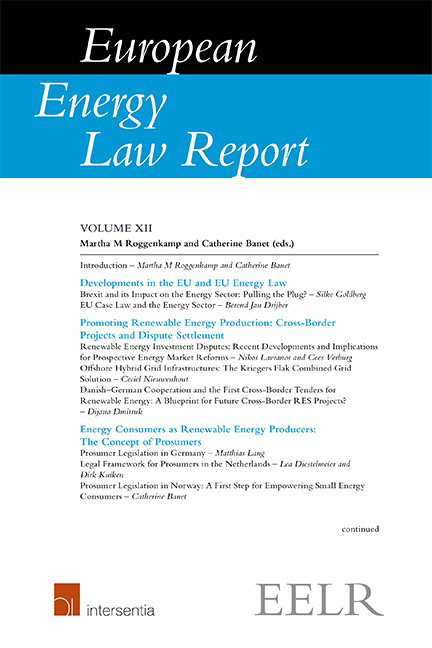Book contents
- Frontmatter
- Preface
- Contents
- List of Abbreviations
- List of Contributors
- Introduction
- PART I Developments In The EU and EU Energy Law
- PART II Promoting Renewable Energy Production: Cross-Border Projects And Dispute Settlement
- PART III Energy Consumers As Renewable Energy Producers: The Concept Of Prosumers
- PART IV Balancing Renewable Electricity Production Withsupply Security: National Experiences With Capacity Mechanisms
- Chapter IX The Capacity Market in Great Britain
- Chapter X Capacity Mechanisms in Germany
- Chapter XI The French Capacity Mechanism
- PART V Promoting The Use Of Sustainable Gas And Security Of Gas Supply
Chapter X - Capacity Mechanisms in Germany
from PART IV - Balancing Renewable Electricity Production Withsupply Security: National Experiences With Capacity Mechanisms
Published online by Cambridge University Press: 31 January 2019
- Frontmatter
- Preface
- Contents
- List of Abbreviations
- List of Contributors
- Introduction
- PART I Developments In The EU and EU Energy Law
- PART II Promoting Renewable Energy Production: Cross-Border Projects And Dispute Settlement
- PART III Energy Consumers As Renewable Energy Producers: The Concept Of Prosumers
- PART IV Balancing Renewable Electricity Production Withsupply Security: National Experiences With Capacity Mechanisms
- Chapter IX The Capacity Market in Great Britain
- Chapter X Capacity Mechanisms in Germany
- Chapter XI The French Capacity Mechanism
- PART V Promoting The Use Of Sustainable Gas And Security Of Gas Supply
Summary
INTRODUCTION
This chapter presents the introduction and use of capacity mechanisms in Germany. The background for establishing this regime is the energy transition process, generally referred to as Energiewende, which was adopted in 2010. The chapter starts by exploring the background and rationale for introducing a system of capacity mechanisms in Germany, before presenting the way in which the first capacity reserve mechanisms were developed and shaped in 2012 and how this early regime was impacted by the European Commission's Sector Inquiry on Capacity Mechanisms in 2015. This is followed by an analysis of the four capacity reserve mechanisms that currently apply. The chapter concludes by looking at the functioning of the German electricity sector in the future and the role of these capacity mechanisms in the German electricity market.
RATIONALE FOR THE ADOPTION OF CAPACITY MECHANISMS IN GERMANY
Capacity mechanisms in Germany currently consist of four capacity reserve facilities. They are established and described in detail in the German Energy Industry Act (Energiewirtschaft sgesetz, EnWG). The reserve facilities are intended to ensure temporarily the security of supply in the electricity market against various consequences resulting from the transition process called the Energy Transition (Energiewende) in the German energy-only-market. The German Energy Transition was officially adopted by the German Government in September 2010 in a strategic policy document called the Energy Concept. The Energy Concept provides a vision for the energy market until the year 2050. The defined objective is to achieve a transition from electricity generation based on fossil fuels to generation from renewable energy sources, an exit from nuclear power and the reduction of greenhouse gas emissions. These different components of the Energy Concept are reviewed below.
RENEWABLE ENERGY
The first main objective of the Energy Transition is the switch towards more electricity generation from renewable energy sources. 4 In Germany, this switch relies primarily on wind power (both onshore and off shore) and solar energy, with biomass, hydropower and geothermal playing a lesser role. In 2016, renewable energies already represented 32.2 % of gross electricity generation in Germany. The Energy Concept's ambitious targets have been set even higher by the Renewable Energies Act (Erneuerbare Energien Gesetz, EEG).
- Type
- Chapter
- Information
- European Energy Law Report XII , pp. 209 - 230Publisher: IntersentiaPrint publication year: 2018

